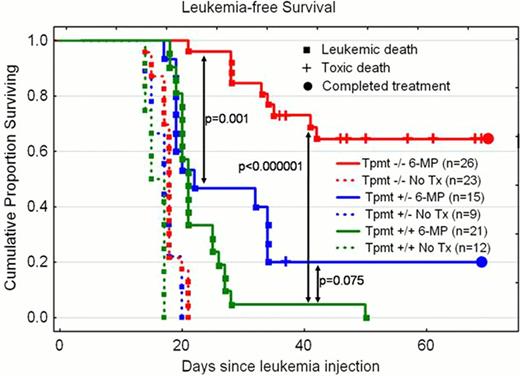Abstract
Abstract 3560
Thiopurines are routinely used to treat many hematopoietic malignancies, including acute lymphoblastic leukemia (ALL), as well as inflammatory and autoimmune diseases. Common polymorphic null alleles among humans in thiopurine methyltransferase (TPMT) render 1 in 400 patients equivalent to homozygous knock-outs (−/−), 10% of patients equivalent to hemizygous (+/−), and 90% of patients comparable to wild-type (+/+) status for TPMT enzyme activity. TPMT activity is inversely related to the accumulation of active thioguanine nucleotide metabolites among patients, resulting in a higher risk for myelosuppressive adverse effects if routine doses are given to −/− compared to +/− compared to +/+ patients. However, the impact of the host TPMT polymorphism on antileukemic efficacy in the clinic is less clear.
We generated a murine model of ALL by transducing bone marrow cells of Arf-null mice on the 129X1SvJ background (Tpmt +/+) with a retroviral vector encoding p185 BCR-ABL and luciferase, and culturing them for 7–10 days. We injected 2000 BCR-ABL+ pro/pre-B cells into Tpmt-deficient (−/−), heterozygous (+/−), or wild type (+/+) unconditioned syngenic recipients and compared the antileukemic efficacy when treating with a relatively low dose of mercaptopurine (equivalent to 7–9 mg/m2—such as would be tolerated by patients homozygous for null TPMT alleles). Treatment was started one day after injection of leukemia cells and continued for 70 days or until mice were sacrificed due to moribund state (usually due to illness from leukemia). To mimic clinically relevant treatment regimens, methotrexate was injected intraperitoneally (IP) at 1 mg/kg, once a week. Mercaptopurine was administered in the drinking water at 10 mg/L, for an estimated delivered dose of 2 – 2.5 mg/kg/day of mercaptopurine.
Erythrocyte TPMT activity segregated by Tpmt genotype as expected and was comparable to the differences observed in patients: 0.6 U/ml in Tpmt −/−, 6.7 U/ml in Tpmt +/−, and 11.6 U/ml in Tpmt +/+ mice (p =0.008, n=2 for each genotype). As expected, the median survival (± standard error) was similar among Tpmt genotypes in untreated mice: 16 (± 0.4) days for Tpmt +/+, 17 (± 0.7) days for Tpmt +/−, and 18 (± 0.4) days for Tpmt −/−. The difference in leukemia-free survival by Tpmt genotype was profound: at 30 days after the start of treatment, 5% (± 9%) of Tpmt +/+ mice, 47% (± 26%) of Tpmt +/− mice, and 85% (± 14%) of Tpmt −/− mice were surviving (p = 5×10−8, Figure), indicating a substantial impact of host Tpmt status on thiopurine antileukemic effectiveness. In vivo imaging of luciferase-marked ALL cells confirmed an intermediate response phenotype for the Tpmt heterozygous mice (p = 0.00001). With higher doses (closer to the doses tolerated by patients homozygous for wild-type alleles, equivalent to 50–70 mg/m2/day), leukemia-free survival improved in the Tpmt +/+ and Tpmt +/− mice, comparable to the survival of Tpmt −/− mice treated with the low dose of mercaptopurine. These findings support the notion that germline polymorphisms in Tpmt, even in the heterozygous state, affect not only host tissue toxicity, but antitumor effectiveness as well.
Evans:St. Jude Children's Research Hospital: Dr. William Evans receives a portion of the income St. Jude receives from licensing patent rights related to TPMT polymorphisms., Dr. William Evans receives a portion of the income St. Jude receives from licensing patent rights related to TPMT polymorphisms. Patents & Royalties. Relling:St. Jude Children's Research Hospital: Dr. Mary Relling receives a portion of the income St. Jude receives from licensing patent rights related to TPMT polymorphisms and GGH polymorphisms., Dr. Mary Relling receives a portion of the income St. Jude receives from licensing patent rights related to TPMT polymorphisms and GGH polymorphisms. Patents & Royalties; Sigma-Tau Pharmaceuticals: Research Funding.
Author notes
Asterisk with author names denotes non-ASH members.


This feature is available to Subscribers Only
Sign In or Create an Account Close Modal